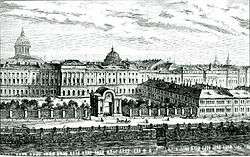Herzen University
The Herzen State Pedagogical University of Russia (formerly Leningrad State Pedagogical Institute) is one of the largest universities in Russia. Located in Saint Petersburg, it operates 20 faculties and more than 100 departments. Embroidered in its structure are the Institute of Pre-University Courses, the Institute of Continuous Professional Development, and the Pedagogical Research Center. The university is named after the Russian writer and philosopher Alexander Herzen.
 Coat of arms of the Herzen University | |
| Established | 1797[1] |
|---|---|
| Chancellor | Sergey Bogdanov (acting rector)[2] |
| Vice-Chancellor | Gennady Bordovsky (ceremonial President)[3] |
| Students | 18,000 |
| Location | , 59°56′2″N 30°19′10″E |
| Affiliations | Network Association of Universities "Pedagogical staff of Russia"[4] |
| Website | www |
History
The university dates its creation to 13 May [O.S. 2 May] 1797, when Emperor Paul I of Russia gave an independent status to the Saint Petersburg foundling house established by Ivan Betskoy and put it under the patronage of Empress Maria Feodorovna. The Imperial Foundling House eventually developed into the modern Pedagogical University.[5]
Betskoy's humanistic ideas furnished the basic principles of the foundling house. The strong pedagogical traditions and consistency in education were passed from one generation to the next and were finally inherited by The State Russian Herzen Pedagogical University. The foundling house was based in a unique architectural complex: the palaces of the earl Kirill Razumovsky and Aleksey Grigorievich Bobrinsky on the Moyka in present-day Saint Petersburg.
The Imperial Foundling House developed as a complex educational establishment carrying progressive ideas of upbringing based upon charity and patronage. It mainly took in destitute and deprived children: foundling orphans, disabled children, and children from failed marriages. Besides being an educational establishment and a center for childcare, the foundling house had an operating hospital. Surrounding village districts had for the first time access to free pediatric care.

The foundling house laid the basis for women's pedagogical education across the country. In 1837, the "Women's Foundling Institute" was established on the basis of the House's higher classes. After 1885 it was called Nicholas' Foundling House. Its graduates were taught by a tutor, a music and dancing pedagogue and a French language teacher. The vast experience of the Nicholas' Foundling house gave rise to the establishment of the first institution for pedagogical higher education: the Women's Pedagogical Institute that was established in 1903.
Concerned with the foundling house is the onset of Russian applied correctional pedagogy. In 1806, a new unit appeared in the structure of the house. It was a college for the deaf, the first educational establishment for disabled children in Russia. Here, the first Russian pedagogues for deaf children were educated and their first works on the subject were created.
In 1864, a pedagogical seminary was created for countryside students who were to become teachers of public schools and colleges. Four years later, a women's college was established that granted specialisations of a fully trained nurse, village school and kindergarten children. This set the basis for Russian pre-school education. During these years, kindergartens were set up in the district of the foundling house. The graduates of the House successfully worked in the new establishments for children. In the Mariininsky department, a reorganised foundling house, famous pedagogues like M. V. Chistyakov worked, the editor-in-chief of "Children's magazine" and the author of numerous books for children, and V. A. Zolotov, an active adherent of the "sound method" of teaching reading and writing and an author of a lot of textbooks for public colleges. K. D. Ushinsky's pedagogical ideas rendered immense influence on restructuring the departments of the foundling house. Thanks to the work of Mariininsky department and its foundling house, the pace of pedagogical education in Saint Petersburg in the beginning of the 20th century took an unusual course. A whole system of establishments dealing with a range of questions concerning birth, pre-school, elementary, high-school, higher education, and correctional pedagogics was set, giving rise to a prototype of the prospective university.

In 1918, the consolidation process of Mariinsky department and foundling house-related establishments started. In the same year, the Women's Pedagogical University was renamed the First Pedagogical Institute. Based on the Teachers' Board, the second Pedagogical Institute was established. On 17 October 1918, the third Pedagogical Institute was created. In 1918, the foundling house-related establishments were reorganized into the Pre-school Education Institute and Social Education Institute. These were the first higher education facilities in Russia that specialized in pre-school and primary school education and defectology. In the period between 1922 and 1925, the first, second, and third Pedagogical Universities, the Pre-school education Institute, the Social Education Institute, and the Psychoneurological Institute were merged. The united establishment was named State Leningrad Herzen Pedagogical Institute.
Notable staff and alumni
Over the years, the university has been the workspace for outstanding scientists, academicians, and professors. Many of them initiated worldwide known scientific schools, thus making a valuable input in development of Russian science.
- Anan'ev B. G, psychologist
- Aleksandra Andreevna Antonova (1932–2014), teacher and writer
- Alexander Kushner, poet (graduated from the university)
- Berg, R. L., geneticist
- Bykov K. M., physiologist
- Nina Dyakonova, English literature historian
- Efim Etkind, Russian and Western literature historian
- Alexander Fersman, geologist
- Grigorii Fichtenholz, mathematician
- Ginzberg A. S., geologist
- Boris Grekov, historian
- Hvolson O. D., physicist
- Ivanov I. P., pedagogue
- Knipovich N. M., zoologist
- Komarov V. L., botanist (who later became President of Russian Academy of Sciences)
- Kon I. S., sociologist and sexologist.
- Igor Kurchatov, physicist
- Mikhlin S. G., mathematician
- Orbeli L. A., physiologist
- Parygin B. D., social psychologist
- Pinkevich A. M., pedagogue
- Rubinstein S. L., psychologist
- Lat, B., pedagogue
- Semenov-Tjan-Shanskij V. P., geographer
- Shokalskii U. M., geographer
- Skazkin F. D., botanist
- Sochava V. B., geographer
- Soroka-Rosinskii V. N., pedagogue
- Struve V. V., historian
- Volodin A. P., linguist
- Oktyabrina Voronova (1934–1990), poet
- Vygotskii L. S., psychologist
- Tarle E. V., historian
References
- "The history of The Herzen State Pedagogical University of Russia". Museum of the Herzen University.
- "Rector Of The Herzen University". Herzen University.
- "President Of The Herzen University". Herzen University.
- "Network Association of Universities "Pedagogical staff of Russia"". Herzen University.
- .